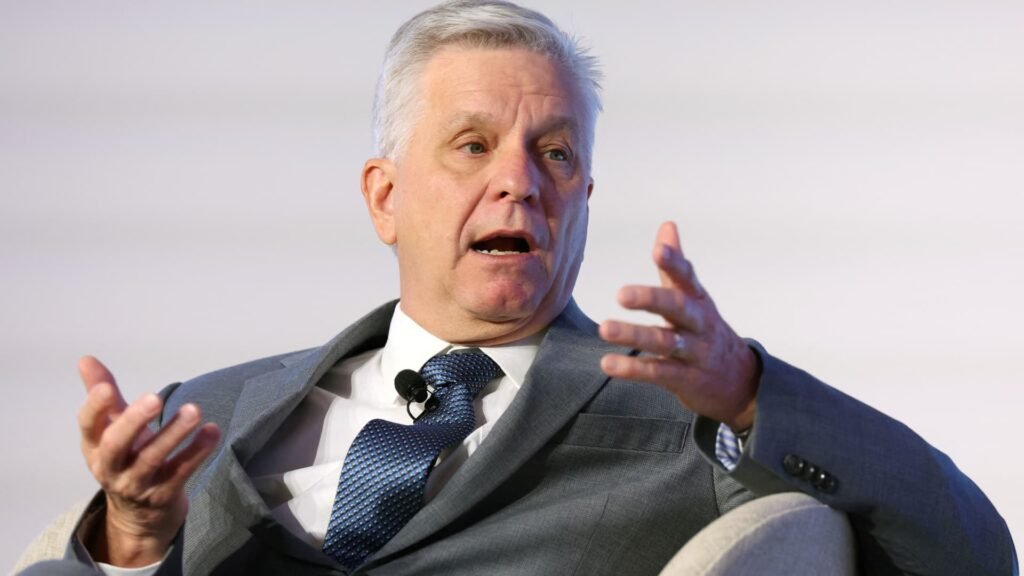On Friday, Federal Reserve Governor Christopher Waller stated he does not anticipate tariffs to significantly increase inflation, suggesting that policymakers should consider reducing interest rates as soon as next month.
In an interview with CNBC, Waller mentioned that he and his fellow officials should approach the situation cautiously, but begin to ease rates since inflation is not a major economic concern, and he believes this trend will continue.
“I believe we could start this as early as July,” Waller said in a “Squawk Box” interview with CNBC’s Steve Liesman. “That’s my perspective, regardless of whether the committee agrees.”
This statement follows the recent decision by the Federal Open Market Committee to maintain its key interest rate, marking the fourth consecutive hold since the last cut in December.
Former President Donald Trump, who appointed Waller during his first term, has been urging the Fed to lower interest rates to lessen borrowing costs related to the $36 trillion national debt.
Waller expressed his concern that the Fed should consider lowering rates to prevent a possible slowdown in the job market.
“If you’re getting concerned about potential negative impacts on the job market, it’s better to act now rather than wait,” he said. “Why delay until we see a significant downturn before we start making rate cuts? I fully support the idea of considering a policy rate reduction in the next meeting, as we shouldn’t wait until the job market is in trouble.”
Following Waller’s comments, stock market futures experienced an uptick.
It’s uncertain how much backing Waller will receive for his viewpoint.
The FOMC, including Waller, voted unanimously to maintain the current rates during this week’s meeting, keeping the benchmark federal funds rate between 4.25% and 4.5%.
Per the “dot plot” of individual officials’ rate expectations for this year, seven of the 19 attendees anticipate rates holding stable, two foresee a single cut, while the other 10 expect two to three reductions. This variance indicates uncertainty amongst policymakers regarding future rate directions, although the median expectation suggests a total of two cuts.
Trump has pushed for significant changes, claiming the benchmark rate should be at least 2 percentage points lower, and even suggested it could fall to 2.5 percentage points below the current level of 4.33%. In comments made before the Fed meeting on Wednesday, Trump criticized Fed Chair Jerome Powell, calling him “stupid” for not advocating for cuts.
Nonetheless, Waller indicated that the committee should be cautious in its approach. Powell’s term as chair lasts until May 2026, and Waller is viewed as a potential candidate for the role. Trump has stated he will share his intentions soon.
“It’s essential to begin slowly and gradually lower rates, ensuring there are no unexpected developments. But initiating the process is crucial,” Waller noted. “We’ve been in a holding pattern for six months waiting for data, and so far, the figures look good. … I don’t believe we should wait any longer; even if tariffs affect us later on, the consequences should remain temporary and not lead to ongoing inflation.”
Other officials have shown hesitance towards cuts, waiting to evaluate the long-term effects of Trump’s tariffs, primarily concerning inflation, the job market, and overall economic growth.
“We’ve been on hold for six months, anticipating a significant impact from tariffs on inflation, but we haven’t experienced that. We’re monitoring the data,” Waller stated. “Since last year, I’ve been advocating that central banks should consider these aspects.”
Powell reiterated at his press conference following the meeting that he believes the Fed can maintain its wait-and-see stance as the job market remains stable. Recent inflation data have shown minimal effects as companies deplete their inventory accumulated prior to the tariff announcement, combined with worries about declining consumer demand and reduced pricing capabilities.
The futures market currently suggests there is almost no chance of a rate cut at the July 29-30 meeting, with the next potential move anticipated in September, according to the CME Group’s FedWatch tool.


